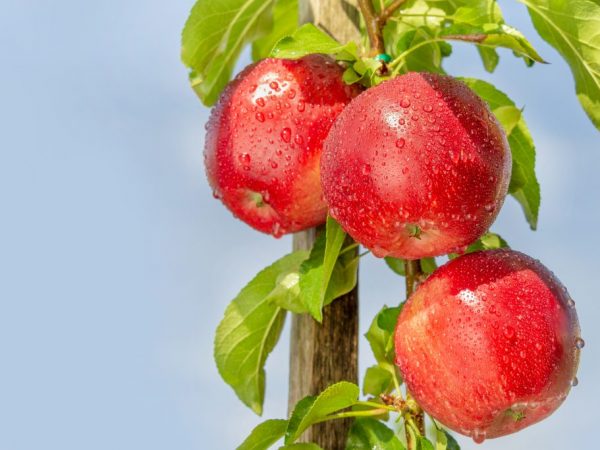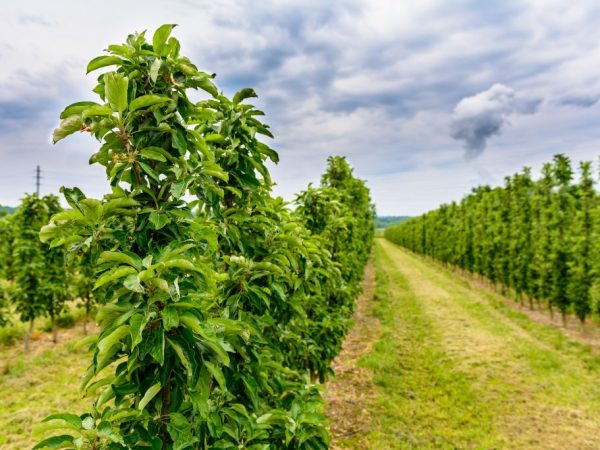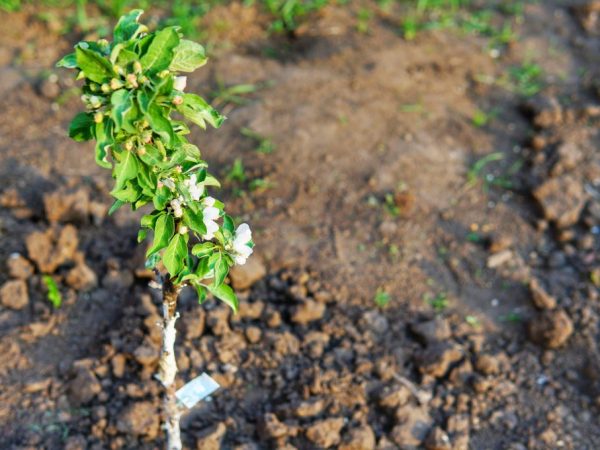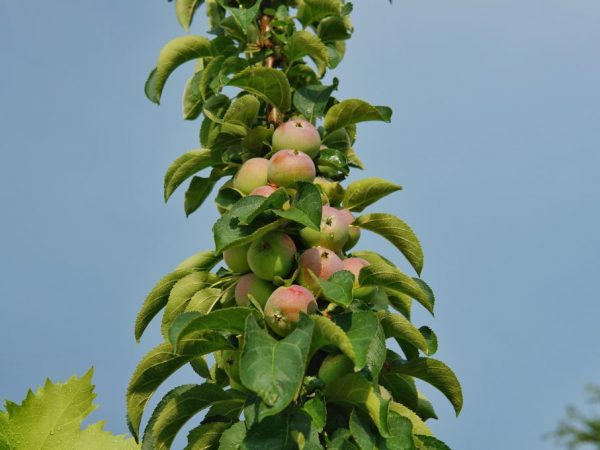Columnar apple chervonets: features of the variety
The columnar apple tree Chervonets was bred back in 1976. Features of this variety: the absence of ordinary branches, small size and high fertility.

Columnar apple tree Chervonets
The main characteristics of the variety
The Danish variety has vertical growth and minimal side branching. Before growing, it is worth considering whether it is suitable for the region: after prolonged frosts, the yield may decrease.
Chervonets is considered an autumn variety; the harvest is obtained at the end of September. The tree can carry up to 10 kg. apples per season. Fruit weight - up to 250 g.
Benefits
The apple tree chervonets has the following positive characteristics:
- large fruits;
- shiny and thick skin;
- beautiful fruits of bright red color;
- juicy and sweet taste of apples;
- delicious light aroma;
- high productivity.
The fruits can be stored for up to a month after harvest.
disadvantages
If the summer is cold, the yield will decrease slightly. Trees must be pollinated. After some time, the columnar apple tree can grow quite extensively, after which it is necessary to carry out additional pruning.
Planting in autumn
When planting in the fall, it is important to follow certain rules.
To plant Chervonets only in warm weather, annual trees are better suited - they take root quickly, grow much faster and yield a harvest.
Care must be taken that the roots are not rotten. The planting area should be spacious and on the sunny side, but it is worth considering that the seedling should not be exposed to strong winds.
The land should be free to pass water and contain the necessary nutrients.
Technology

Trees are planted in rows
Planting is carried out in rows. The gap between trees is more than 50 cm.
The hole is 90x90x90 cm, it must be dug out in advance (2-3 weeks) in order to avoid incorrect location and death of the fruit tree. When digging, separate the top layer of the earth from the bottom, in no case stirring them.
About 4 buckets of humus, superphosphate (100 g), potassium mixture (about 100 g) are poured into the soil, everything is mixed. About 200 g of dolomite flour is added to the mixture and the surface is leveled. After 2 weeks, you need to add the rest of the mixture - so that you get a small tubercle.
A root system is installed on the tubercle, which will contribute to the fact that the neck of the tree will stand above the surface of the territory.
You need to straighten all the roots, add earth from the bottom layer and trample it down. After that, the seedling is well watered and a layer of sawdust or chopped grass is poured. Near the tree, you can fix the support and tie it up.
Planting in spring
The most suitable time for planting a columnar apple tree Chervonets is spring.
You need to be in time before the kidneys have opened yet. The pits are prepared in the autumn. In winter, the soil will become dense and absorb all fertilizers.
It is best to cut off the root tips before planting so that the tree takes root quickly, and also make sure that the root collar is at ground level.
The soil must be carefully tamped down to avoid traces of air inside. Then the tree is well watered and at first they make sure that the seedling is in moist soil.
Care
Caring for this variety includes simple rules.
Watering
In summer, in normal weather, trees should be watered once every 3 days. In hot weather, water it daily.
In the second half of summer, watering is gradually decreasing; by the end, the trees are practically not watered.
To avoid the sudden drying out of the soil, sprinkle the circle at the formation of the trunk with straw or green manure. Thorough watering is carried out once a month.
The crowns of seedlings are watered every 2 weeks, after sunset.
Loosening

The area under the tree must be loosened regularly
After watering, the soil of the seedlings is subject to loosening. Through this process, the earth is filled with oxygen and can retain moisture for a longer period of time.
Saplings planted on slopes should not be loosened, because there is a possibility of damage to the root structure.
You can also plant grass around the trunk of the tree and then mow it regularly.
At the end, the trunk circle is mixed with dry peat or sawdust - this will retain moisture near the roots.
Top dressing
When the apple tree dissolves its buds, it should be fed. It is recommended to use nitrogen fertilizers for fast growth and good yields.
Then, every two weeks, carry out 3 more organic fertilizing: add 2 liters of potassium nitrate and a shovel of manure under the seedlings.
Pruning
To keep the apple tree columnar, excess growths should be removed. This should be done in the first year, before the start of sap flow.
Strongly regrown ones are removed completely, leaving only a couple of buds.
In the middle of summer, the grown branches need to be pinched.
Sanitary pruning is also recommended to remove damaged branches.
In the second year, vertical shoots are cut. On the third - the branches that bore fruit.
The growth point should not be cut off, because the tree will become very branchy.
How to deal with pests and diseases
According to the description, an apple tree can become a home for:
- aphids;
- red tick;
- moths;
- suckers;
- silkworm;
- bark beetle;
- moth and many other pests.
For pest control, insecticidal products should be used. You can also attach a couple of layers of paper to the trunk of the seedling.

At the first signs of illness, treatment should be started.
Saplings of this variety often get sick. Symptoms: fruit rot, branch flattening and dying off.
If any signs are found, the tree should be sprayed immediately. For this, special preparations are used:
- Bordeaux liquid;
- Hom;
- CarboPhos;
- Imidakloprid (Confidor, Admir).
Preparing for winter
During the autumn period, the apple tree must be covered with wood shavings or heat-insulating seals.
If the temperature rises, you need to ventilate the trees, because flower buds can overheat and moist soil will encourage rot around the roots.
The material with which the seedlings are covered must be dense, not have cracks and shelters made of straw, otherwise there is a risk of rodents.
Gardeners reviews
Basically, the reviews about the Chervonets apple tree are positive.
The variety requires careful care and favorable growing conditions, but it produces large and very tasty fruits, and the tree itself is a real decoration of the garden, it is bright and smells good.

